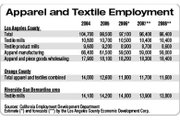2006: So Far, So Good, but Uncertainty Ahead
California’s apparel and textile makers made it through the first half of 2006 in relative health, according to many industry watchers, but the second half of the year is still shrouded in uncertainty for many.
“There’s a sense of cautious optimism,” said Jack Kyser, chief economist with the Los Angeles County Economic Development Corp. “There are more ifs than we would like. We have to watch and see.”
Or, as Sunnie S. Kim, president and chief executive officer of Hana Financial, phrased it: “The manufacturing environment is fraught with tough issues.”
Among the uncertainties is the ongoing fallout from the merger between Federated Department Stores Inc. and May Department Stores Co., which threatens to wreak havoc among many of the smaller manufacturers that sell to the retail giant.
“You have more concentration risk and more doors but it’s still one retailer who will look at the performance of the goods on all doors,” said Andrew Tananbaum, president and chief executive officer of Capital Business Credit LLC.
For many retailers, the uncertainty lies at the cash register. Continued high energy prices mean consumers may be looking for places to save money.
And on the global stage, the turmoil in the Middle East could stymie economic recovery efforts in the United States and throughout the world. “We’re watching the Middle East very closely,” said Kyser. “It could cause us to go into a global recession.”
At the same time, manufacturers and retailers in California should be preparing for an increase in the minimum wage. It seems likely that lawmakers will pass one of the two bills making their way through the California Legislature. Gov. Arnold Schwarzenegger might beat them to it by passing his own minimum wage increase.
“For the retail industry, you are going to get an increase in the minimum wage—that’s a given,” said Kyser, who added that one measure will likely be passed before the end of the year, although the first of the two-increment increases will not begin until 2007. All three proposals recommend an increase from $6.75 to $7.75 an hour. The federal minimum wage is currently $5.15, although there are discussions in Washington, D.C., about raising the federal figure as well.
Energy woes continue
The rising fuel costs have sent reverberations throughout the apparel and textile industry. Fuel prices affect companies’ employees who have to commute long distances, as well as curtailing business travel or air freight shipments because of airline fuel surcharges.
“If someone is building goods for the juniors market and has to air freight [the merchandise], that can be brutal,” said Paul Herold, senior vice president of First Capital Western Region LLC.
But ultimately, the largest impact will be on the consumer’s spending power.
“Apparel manufacturers have seen end users’ disposable income dwindle due to rising fuel costs,” Hana’s Kim said.
Consumers are feeling the pressure, said Kyser, who noted that in Los Angeles, masstransit ridership has increased lately. “That’s, to me, an indication that people are having to make hard choices.
“Any retail service provider for the lowerand middle-income household is starting to feel the impact,” Kyser said.
And it’s not just energy prices that are squeezing consumers’ pocketbooks.
“There’s a lot of other factors—interest rates are up, mortgage rates are going up,” said Martin G. Hughes, partner in Moss Adams LLP. “There’s less consumable income, and if there’s less consumable income, they’re not going to be buying the luxury items.”
Indian summer to Christmas crunch
All this is happening as the apparel industry gears up for its busiest season of the year—Holiday. Southern California’s port traffic hit an all-time high in June, according to Kyser. Port officials say it’s been full-steam-ahead, thanks to its 1-year-old PierPass program, which provides incentives to move cargo during off-peak hours at the Los Angeles and Long Beach ports. But reports from manufacturers are mixed as to whether imports are sailing through the ports or getting stuck in a traffic jam. Some of the larger importers are reporting a slowdown at the ports.
Before the Christmas crunch comes, the industry will have to weather one of the hottest summers on record, with temperatures in many parts of the United States remaining in the triple digits. All around the country you’re seeing a hot streak that’s keeping a lot of shoppers in on the weekends,” said Harry Friedman, senior vice president of Rosenthal & Rosenthal in Woodland Hills, Calif. “[Retailers are] going to be probably 30 days behind their buying for fall because of the weather. Not too many people are feeling like they want to get out there and shop for fall clothes when it’s 100 degrees out.”
Business as usual
Nonetheless, many industry watchers say it’s all par for the course for the industry.
“Our apparel clients have been below what’s expected in terms of sales volume for the first half—not significantly, but certainly it’s forcing them to rely a little bit more on their lenders and borrowers and banks to help with the financing side,” said Friedman, who expects the trend to continue through the rest of the year.
Companies with a recognized consumer brand seem to be faring best, according to Moss Adams’ Hughes. “We continue to see branded companies do well. The consumers continue to look to the branded labels. Anybody who has carved out a niche in the marketplace is doing well.”
Hughes also said he’s seen a slight slowdown in the high-end denim business, but that has more to do with a crowded marketplace rather than external factors. Even so, denim and quick-turn business continue to help buoy the Los Angeles marketplace.
“The L.A. community has maintained robustness because of denim—that’s given a lifeline to a lot of L.A. contractors,” said First Capital’s Herold. “There’s also a number of converters that are doing pretty darn well. They are feeding the quick-turn mavens.”






















